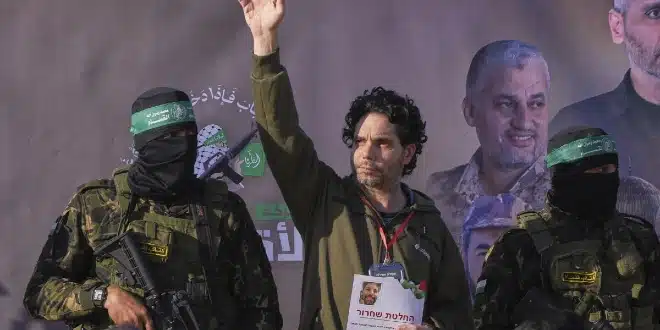The ongoing ceasefire in Gaza has allowed for the release of hostages, with two Israeli captives arriving back in Israel on Saturday after being handed over by Hamas to the Red Cross. This marks the fourth exchange of hostages under the truce agreement, with dozens of Palestinian prisoners expected to be freed from Israeli detention in return.
The ceasefire, which began on January 19, has temporarily paused hostilities in the deadliest conflict between Israel and Hamas. The truce has not only halted fighting but has also facilitated increased humanitarian aid deliveries to Gaza.
Among those released were 35-year-old Yarden Bibas and 54-year-old French-Israeli Ofer Kalderon, both of whom were abducted during the Hamas-led incursion into Israel on October 7, 2023. After their release, they were transported to a military reception center, where groups of supporters lined the roads waving Israeli flags.
Their handover was conducted in Khan Younis, where Hamas militants oversaw the transfer in an orderly manner, a stark contrast to the chaotic scene of a previous hostage release that had angered Israeli officials. Another captive, 65-year-old American-Israeli Keith Siegel, is also set to be released later, with arrangements in place for his transfer in Gaza City.
Under the ceasefire’s initial six-week phase, 33 Israeli hostages are scheduled for release in exchange for nearly 2,000 Palestinian prisoners. However, Israeli authorities report that Hamas has informed them that eight of those hostages were either killed during the October 7 attack or have died in captivity.
The agreement also includes provisions for the evacuation of wounded Palestinians. On Saturday, several injured civilians were expected to cross into Egypt through the Rafah border, which had been closed by Israel in May. A European Union mission had arrived the day before to prepare for the crossing’s reopening. The first phase of the truce also aims to facilitate the return of displaced Palestinians to northern Gaza and expand humanitarian assistance to the war-ravaged region.
According to Gaza’s Health Ministry, 50 sick and wounded children, along with 61 accompanying family members, were scheduled to leave through Rafah.
In Israel, Bibas’ release has renewed focus on the fate of his wife, Shiri, and their two young sons, all of whom were taken from Kibbutz Nir Oz during the October attack. A widely circulated video showed Shiri carrying their red-haired children—four-year-old Ariel and nine-month-old Kfir—wrapped in a blanket as they were taken captive. Kfir was the youngest of approximately 250 people abducted that day, and his situation has become a symbol of Israeli distress over the hostage crisis.
Hamas has claimed that Shiri and her sons were killed in an Israeli airstrike, though Israeli officials have not confirmed this. However, a military spokesperson recently acknowledged that their fate remains uncertain.
Bibas was reportedly held separately from his family, and images from his abduction suggest he was injured at the time. Kalderon, who was also taken from Kibbutz Nir Oz, was welcomed home by his family in Kfar Saba, north of Tel Aviv. His children, Erez and Sahar, who were abducted alongside him, had been freed in an earlier ceasefire in November 2023. Their relatives expressed relief at their reunion, with one family member stating, “We will soon be whole again.”
Keith Siegel, originally from North Carolina, was taken hostage from Kibbutz Kfar Aza along with his wife, Aviva, who was freed in November. Since then, she has led an active campaign advocating for the release of remaining captives, including her husband.
Meanwhile, Israel plans to release dozens of Palestinian prisoners as part of Saturday’s exchange, including individuals serving extended or life sentences.
During a previous ceasefire in November 2023, over 100 hostages were freed, but around 80 remain in Gaza, with Israeli officials estimating that at least a third of them are no longer alive. Hamas has confirmed that eight of the 33 hostages scheduled for release in this phase are deceased.
Negotiations are set to begin next week for a second phase of the truce, which aims to secure the release of remaining hostages and possibly extend the ceasefire. However, if no agreement is reached, hostilities could resume by early March.
Israel maintains that it remains committed to dismantling Hamas, even as the group has reasserted its control over Gaza following the truce. Some members of Prime Minister Benjamin Netanyahu’s coalition, particularly from far-right factions, are pushing for an immediate resumption of military operations.
Hamas, on the other hand, insists it will not release additional hostages unless there is a complete cessation of the war and a full Israeli withdrawal from Gaza.
The war erupted on October 7 when Hamas launched an unprecedented attack that killed approximately 1,200 people, mostly civilians. In response, Israel’s military campaign has resulted in the deaths of over 47,000 Palestinians, with more than half being women and children, according to Gaza’s Health Ministry. While the Israeli military claims to have eliminated over 17,000 Hamas fighters, it has not provided independent verification of these figures. Israeli officials also attribute the high civilian death toll to Hamas’ practice of operating within densely populated areas.


